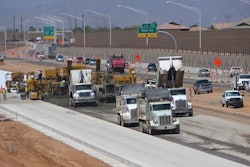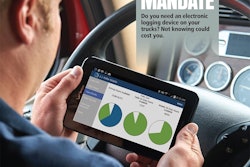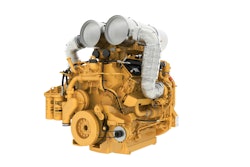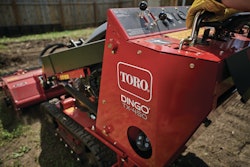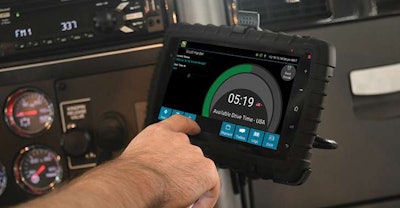 Hardwired systems like the GPS Insight ELD 2000 are less likely to break or get lost.
Hardwired systems like the GPS Insight ELD 2000 are less likely to break or get lost.Adding Electronic Logging Devices (ELDs) to your fleet doesn’t need to be a nightmare. Consider the following factors before you commit (and scroll to the bottom of the post to see an overview of construction-friendly solutions):
BYODs vs fixed systems.
There are two types of ELDs: fixed units that remain in the truck, and BYODs or bring your own device. BYODs can be as simple as an app on a driver’s smart phone or tablet or a company supplied mobile device. A fixed unit is hard wired and professionally installed.
BYODs communicate with the truck ECM via a Bluetooth or wireless connection to a dongle inserted in the truck’s diagnostics port. The advantage here is that the BYODs can be removed from a cradle and used to take photos of maintenance issues. And if you have trucks with multiple drivers and each driver needs his or her own HOS records, BYOD is the way to go.
Fixed systems are less likely to break or be lost, says Pete Allen, vice president of sales for North America, MiX Telematics. If you’re required to have an ELD and you use your phone, losing it puts you out of compliance. Fixed systems also mean the fleet has better control over the data, and because they are homogenous, they are easier to maintain, Allen says.
Some fleets have concerns about drivers bringing their personal tablets or smart phones into the cab to serve as their ELD.
With a personal device, fleets risk drivers using the company’s data plan to watch movies, chat or surf the web.
“One company I know spent $26,000 in overages for their data because their drivers were watching movies in their off time,” says Marc Lonson, president M2M In Motion. “With a dedicated tablet, you don’t give them that option and you can manage that a lot easier. You only need about 500 megabytes a month to run an ELD.”
Hardware costs for fixed systems can run from $400 to as much as $2,000 per unit. BYOD systems start at about $70 and go up to around $500. For both types of devices, you pay a monthly subscription fee for the data, which can run approximately $15 to $50 per device.
Open architecture vs out of the box
Most ELD and telematics solutions use open architecture and software as a service, or SaaS, meaning the device you have in the cab is a “dumb” terminal. All the rule sets and programming reside on the vendors’ servers and are pushed out to your device.
This has two advantages. Many open architecture systems can be integrated with other systems from other vendors such as driver cameras or fuel cards. And if the FMCSA or your state DOT decides to tweak or change any of the rules, the vendor simply makes that change to the software on their servers and automatically pushes it to all the customers’ devices.
Out of the box systems, by contrast, are not as easily changed, although they’re usually less expensive. This may be more important to owner-operators or small firms with just one or two trucks.
Payment options
Many customers pay cash for the hardware and then a monthly subscription for the data. Some vendors ask for contracts, anywhere from one to five years. But you also can find subscription-free services where you only pay month-to-month.
If you don’t want to pay up front for the hardware, you can also find plans that roll that cost into a lease that bundles the data subscription and the lease payments on the hardware into one price. These contracts typically last until the hardware is paid off.
ELD/telematics system features
A robust ELD or other telematics system can offer dozens of features to improve your business processes and make your fleets more productive. Before buying an ELD solution, make sure it can handle the special requirements of tracking construction hours of service and exemptions. On page 10-11, we detail in chart form what each vendor offers.
Here are some features to consider:
DRIVERS
Driver monitoring. Telematics systems can measure harsh braking, speeding, harsh turns and other irregular behavior and compile scores for each driver. You can use this data to coach poor performers, but can also exonerate drivers who are not at fault after an accident. Some vendors can provide driver cams as well or integrate with third party driver cams. In addition to alerts, most of these systems provide a scorecard so that you can see who your best drivers are and who needs help or coaching. In-cab verbal feedback and mobile applications to allow for peer-to-peer gamification and incentive programs are other options.
Proactive notifications and warnings. The complexity of the HOS regulations and the multi-task nature of construction work can leave some drivers unsure of how much drive time they’ve accumulated. Look for a telematics system that will warn your drivers when they’re getting close to the limits or are cleared for a restart.
DVIRs. The law requires a driver vehicle inspection report for many vocational trucks. With the right telematics product, drivers can record their pre- and post-trip inspections electronically. If they have a mobile device, they can also take photos of maintenance issues and send those back to the shop. Inspection records can be sent back to the office. If your telematics product times the inspection, you can see which drivers are doing a thorough job and which are too hasty.
MAINTENANCE
Engine diagnostics. ELD and telematics systems tap into the truck engine’s ECM. This allows you to see things like overheating, oil pressures and the like.
Maintenance alerts. Telematics systems can keep track of your PMs better than paper records. These are based on hours or miles and are sent simultaneously to the driver, managers and the shops so that nobody drops the ball.
Off-road telematics. If you run a mixed fleet of on-road trucks and off-road equipment, having a telematics provider that can do both simplifies your processes and eliminates the need to jump from website to website to gather information.
Tire pressure monitoring. Many of today’s trucks and automobiles can track tire pressures using Bluetooth enabled tire pressure monitoring devices. Including this in your telematics feeds can help save fuel, save tread life and make your trucks safer by alerting you to tire pressure problems before they become serious.
LOGISTICS
Geofencing. ELD systems use GPS to track the truck’s position, making it easy to create a virtual “fence” on a digital map in the office and receive alerts anytime a truck strays beyond the it. This prevents unauthorized use and has been a very popular – some would say the most popular – feature of truck telematics for many years.
Route planning. Route planning lets you move drivers around difficult or slow traffic conditions or determine the most efficient route for them to take on things like concrete pours or when hauling hot asphalt.
MANAGEMENT
IFTA/fuel tax reporting. Fuel tax reporting capabilities eliminate the need to spend hundreds of hours a year collecting, organizing and tabulating drivers’ fuel receipts. Drivers simply enter the fuel amount and taxes paid at each refueling stop and the system sends the totals to the office and calculates them automatically.
PTO tracking. In most states, you do not have to pay fuel taxes on the fuel your truck burns when the PTO is engaged – when the truck is stationary but doing work like mixing concrete. The more sophisticated telematics systems will automatically read your engine codes and record this time. Backend software can then calculate the fuel burn and compile that for your tax rebates.
Small tool tracking. Of interest to construction contractors, small tool tracking devices can monitor the whereabouts of non-powered assets and integrate that data into your overall telematics platform.
Use the scrollbar at the bottom of the chart to move left and right to see more data. To download the full ELD Mandate Guide (which included a much easier to read version of the chart), click here.





